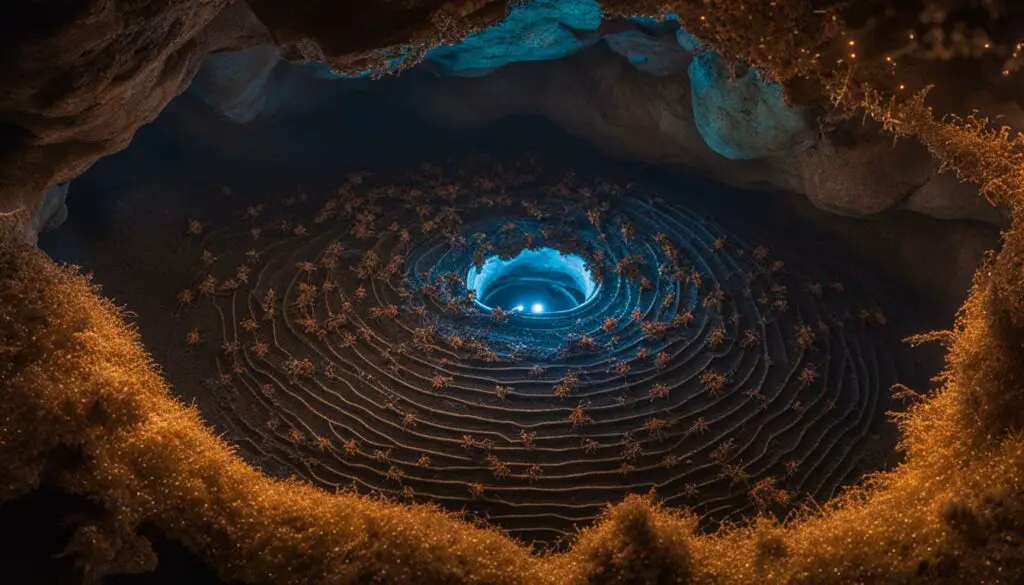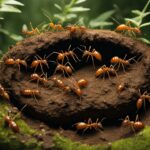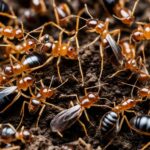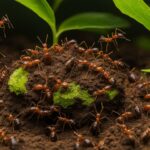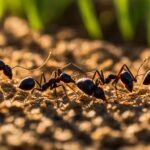Ants are remarkable creatures that exhibit complex social structures within their colonies. From their behavior to their organizational systems, exploring the world of ants provides a fascinating insight into the intricacies of insect societies.
Ant colonies, with their intricate social structures, are a captivating subject of study. These tiny insects form organized communities where every member has a specific role and contributes to the overall functioning of the colony. By delving into the world of ants, we can uncover the secrets behind their behavior, communication methods, and division of labor.
Key Takeaways:
- Ants have diverse social systems within their colonies, showcasing complex organization.
- Ant behavior and communication methods, such as chemical signals, play a crucial role in their social structures.
- Understanding ant anatomy and life cycle helps comprehend their roles within the colony.
- The queen ant plays a vital reproductive role in the success and growth of the colony.
- Ants contribute to ecosystem balance through nutrient cycling, seed dispersal, and soil aeration.
The Incredible Diversity of Ants
Ants are not only ubiquitous but also incredibly diverse in their species and behaviors. With an estimated one-third of the world’s insect biomass composed of ants, these tiny creatures play a vital role in ecosystems around the globe. There are roughly 12,000 known species of ants, each displaying unique characteristics and adaptations that contribute to their success in different environments.
Ant species can vary greatly in size, color, and behavior. Some ants, like the bullet ant (Paraponera clavata), are known for their painful stings and large size, while others, like the leafcutter ants (Atta spp. and Acromyrmex spp.), are famous for their impressive leaf-cutting and farming activities. Each species has its own ecological niche, engaging in specific interactions with plants, fungi, and other animals to maintain the balance of ecosystems.
To better understand the diversity of ants, it’s helpful to visualize the range of species. The table below showcases some notable examples:
| Ant Species | Characteristics |
|---|---|
| Leafcutter ants | Known for their intricate leaf-cutting activities; cultivate fungi as a food source |
| Honeypot ants | Have specialized worker ants that store liquid food in their bodies to sustain the colony |
| Pugnacious ants | Aggressive ants that can quickly overwhelm and eliminate other small animals, such as crabs |
As seen in the table above, each species of ant contributes to the rich tapestry of diversity within the insect world. Their varied behaviors, adaptations, and interactions make them a fascinating subject of study for scientists and nature enthusiasts alike.
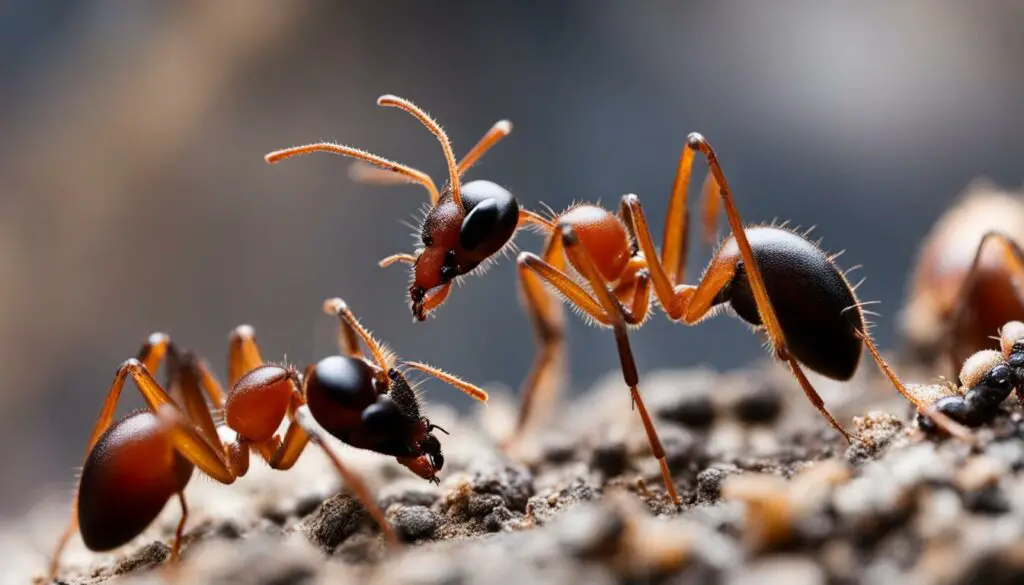
The Importance of Ant Ecosystems
Ants play a crucial role in maintaining the balance and health of ecosystems. They contribute to nutrient cycling by scavenging and decomposing organic matter, helping to break down dead plant material and recycling nutrients back into the soil. Ants also play a significant role in seed dispersal, as they transport and bury seeds, aiding in the regeneration of plants.
Furthermore, ants’ interactions with other organisms, such as plants and fungi, contribute to the overall stability and diversity of ecosystems. Some ant species form mutualistic relationships with plants, providing protection against herbivores in exchange for food or shelter. Others engage in symbiotic relationships with fungi, cultivating fungal gardens within their nests for nourishment.
Overall, the incredible diversity of ants and their essential ecological functions highlight the importance of preserving these fascinating creatures and the ecosystems they inhabit. By studying and understanding ants, we can gain valuable insights into the complexity of nature and work towards conserving biodiversity for future generations.
Anatomy and Life Cycle of Ants
Understanding the anatomy and life cycle of ants is crucial in unraveling the complexities of their social structures. Ants go through various stages of development, starting from eggs and progressing to larvae, pupae, and finally becoming adult ants. Each stage has unique characteristics that contribute to their roles within the colony.
Ant anatomy plays a significant role in their ability to perform specialized tasks within the colony. They have segmented bodies with three distinct sections: the head, thorax, and abdomen. The head contains vital organs such as the brain, eyes, and antennae, which they use for sensing their environment and communicating with other ants. The thorax is responsible for locomotion, housing the powerful muscles that enable ants to move and carry objects many times their own body weight. The abdomen houses essential organs like the digestive system and reproductive organs, which differ depending on the ant’s caste.
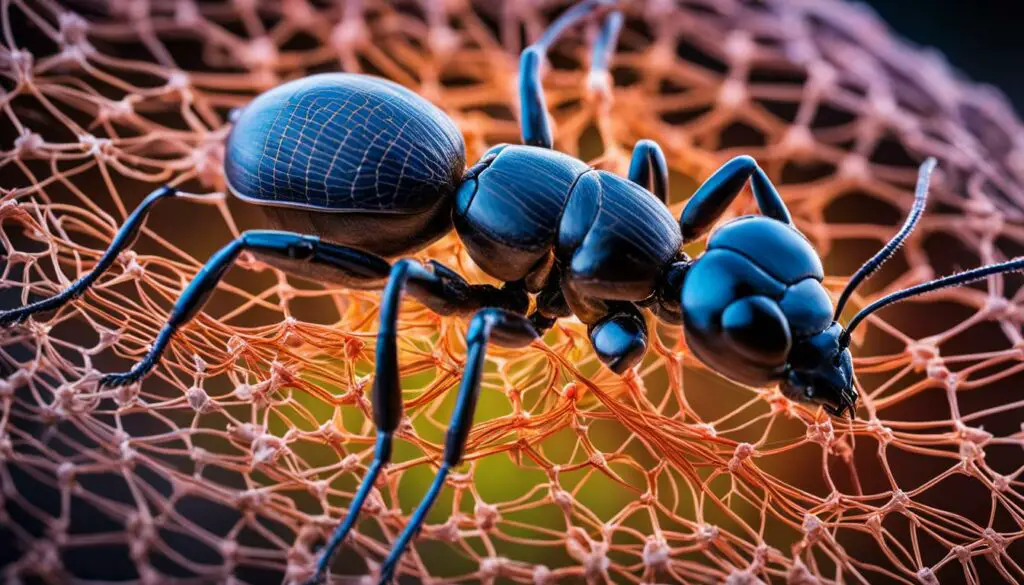
Life Cycle Stages of Ants
Ants undergo a complete metamorphosis, meaning they go through distinct life cycle stages. Each stage serves a specific purpose within the colony and contributes to the overall organization and functioning of the social structure.
- Egg: The ant life cycle begins with the laying of eggs by the queen ant. These tiny, oval-shaped eggs are usually white and are carefully cared for by the colony.
- Larva: Once the eggs hatch, they transform into larvae. Larvae are legless, worm-like creatures that depend on the worker ants for food and protection. They go through several instars, shedding their skin and growing larger at each stage.
- Pupa: After the larval stage, ants enter the pupal stage, which is similar to the cocoon stage of butterflies. Inside the pupa, the ant undergoes a complete transformation, developing its adult body structure and characteristics.
- Adult: Once the metamorphosis is complete, the ant emerges as an adult. The adult stage is when ants assume their specific roles within the colony, whether as workers, soldiers, or reproductives.
Understanding the anatomy and life cycle of ants provides valuable insights into their social structures and behaviors. By unraveling the intricacies of their development and physical characteristics, scientists can better comprehend the fascinating world of ants and the crucial roles they play in various ecosystems.
Table: Comparison of Ant Life Cycle Stages
| Stage | Description | Role |
|---|---|---|
| Egg | Tiny, oval-shaped eggs laid by the queen ant | Beginning of the ant life cycle |
| Larva | Legless, worm-like creatures that rely on worker ants for food and protection | Growth and development |
| Pupa | Transformation stage inside a protective cocoon | Development of adult body structure and characteristics |
| Adult | Fully developed ant with specific roles within the colony | Contributing to the social structure and functioning of the colony |
The Social Organization of Ant Colonies
The social organization of ant colonies is a fascinating subject that reveals the intricate division of labor and hierarchical structure within these remarkable insect societies. Ants live in highly organized colonies where different castes and roles are assigned to each member, ensuring the efficient functioning and survival of the colony. Let’s explore the fascinating ant caste system and how it contributes to the overall organization of ant colonies.
The Ant Caste System
In ant colonies, there are typically three main castes: the queen ants, the worker ants, and sometimes the soldier ants. The queen ant is the central figure of the colony and is responsible for reproduction, laying eggs, and ensuring the growth of the colony. Worker ants, on the other hand, perform various tasks such as foraging for food, caring for the queen’s offspring, and maintaining the nest. Soldier ants, when present, have specialized roles in defending the colony from threats.
The division of labor within the ant colony is striking, with each caste performing specific tasks that contribute to the colony’s success. Worker ants, for example, have different roles depending on their age and experience. Some workers may specialize in foraging, while others focus on nest maintenance or caring for the queen’s offspring. This specialization allows the colony to efficiently allocate resources and maximize productivity.
The social organization of ant colonies is not only structured by caste, but also by complex chemical communication systems. Ants use pheromones, chemical signals, to communicate and coordinate their activities. These chemical cues help ants recognize colony members, mark trails, and convey information about food sources or threats. The intricate interplay between chemical communication and the division of labor ensures the overall functioning and success of the ant colony.
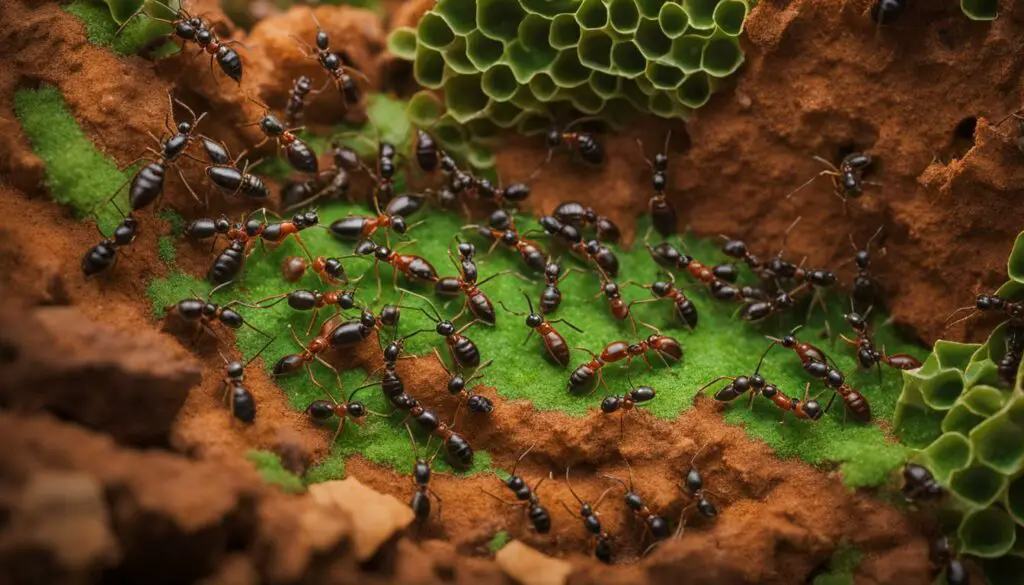
Table: Roles within the Ant Colony
| Caste | Role |
|---|---|
| Queen ants | Reproduction, egg-laying, colony growth |
| Worker ants | Foraging, nest maintenance, caring for offspring |
| Soldier ants (if present) | Defense and protection |
This table provides a summary of the roles within an ant colony. It showcases the distinct responsibilities carried out by each caste, highlighting their essential contributions to the overall organization and functioning of the colony.
Communication Among Ants
Ants have developed intricate communication systems that rely on chemical signals called pheromones. These chemical cues play a vital role in coordinating tasks, marking trails, and recognizing colony members. Through the release and detection of pheromones, ants can effectively communicate and maintain the organization within their colonies.
The use of pheromones allows ants to convey important information to their fellow colony members. For example, when an ant finds a food source, it will lay down a trail of pheromones as it returns to the nest, indicating the location of the food. Other ants can then follow this trail to access the food source, creating a seamless flow of communication and cooperation.
Furthermore, ants use pheromones to recognize their colony members and distinguish them from potential intruders. Each ant colony has a unique chemical signature, which helps them identify and accept their own members. This recognition system ensures that individuals within the colony work together harmoniously and helps prevent conflicts with outsiders.
The Role of Pheromones in Ant Communication
Pheromones are not the only method of communication among ants. They also use tactile and auditory signals, such as touching antennae, drumming on surfaces, or emitting specific sounds. However, chemical communication through pheromones is particularly crucial due to its wide range and long-lasting effects. Pheromones can persist on surfaces even after the ant that deposited them has left, allowing for continuous communication and coordination.
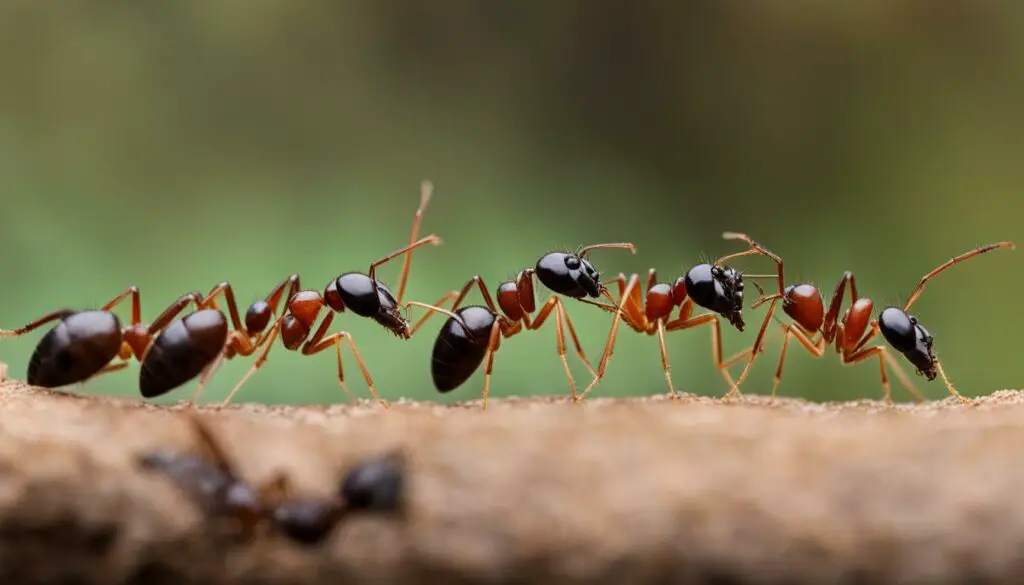
In summary, communication through chemical signals, or pheromones, is a fundamental aspect of ant behavior and social organization. It enables ants to coordinate tasks, share information, and maintain colony cohesion. The intricate communication systems of ants continue to fascinate scientists, who are constantly uncovering new insights into the complexities of ant societies.
The Role of the Ant Queen
Within the complex social structure of an ant colony, the queen plays a crucial role as the reproductive powerhouse. She is responsible for laying eggs, ensuring the colony’s growth, and securing its future. The queen’s sole purpose is to produce offspring, thus contributing to the survival and expansion of the entire colony.
Unlike worker ants, the queen possesses specialized physiological adaptations that enable her to fulfill her reproductive duties. Her abdomen is enlarged, allowing her to store and carry a vast number of eggs. The queen’s reproductive capacity far surpasses that of any other ant in the colony, producing potentially thousands or even millions of eggs throughout her lifetime.
While the queen’s primary role is reproduction, her presence and fertility also influence the behavior and physiology of the worker ants. The queen emits pheromones that communicate her status and reproductive ability, influencing the workers’ behavior and signaling the stability and health of the colony. The queen’s pheromones also suppress the development of reproductive capabilities in the worker ants, ensuring their dedication to other tasks and preventing competition for reproduction within the colony.
Clearly, the survival and prosperity of an ant colony heavily depend on the presence and reproductive success of the queen. Her role as the mother and ruler of the colony ensures the continuation of the species and the growth of the ant society. Understanding the intricate dynamics between the queen and the workers provides valuable insights into the fascinating world of ant social structures.
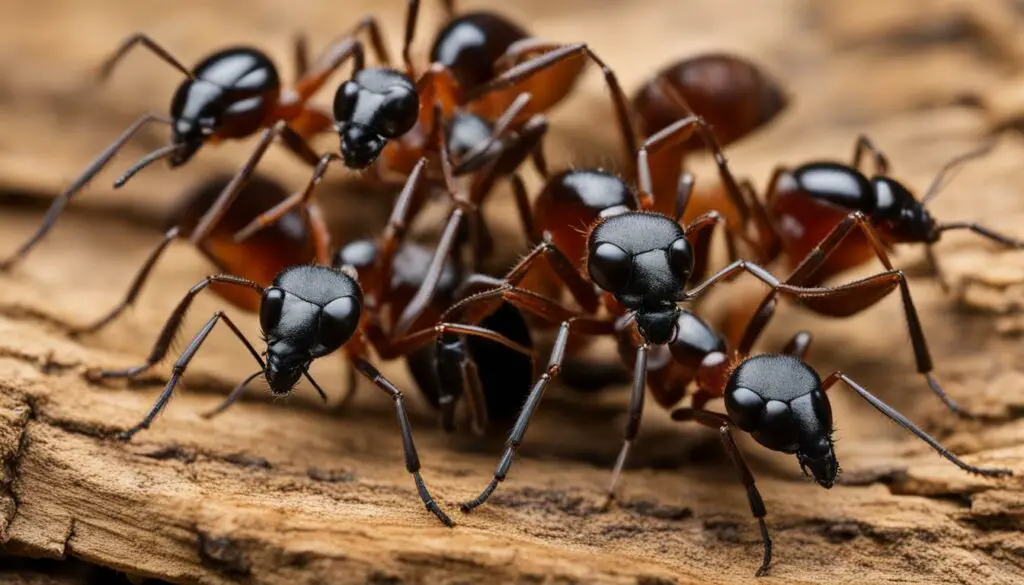
The Queen’s Influence on Colony Dynamics
The queen’s reproductive role extends beyond mere egg-laying. Her presence exerts a profound influence on the behavior and organization of the entire colony. The queen’s pheromones regulate the development of worker ants, dictating their specialization into various tasks such as foraging, nest maintenance, and caring for the queen’s offspring.
Additionally, the queen’s longevity and reproductive success impact the colony’s size and productivity. A thriving queen will produce a larger number of worker ants, resulting in increased efficiency and the ability to exploit greater resources. On the other hand, a struggling or absent queen may lead to a decline in colony size and efficiency, exposing the colony to greater vulnerability.
| Role | Description |
|---|---|
| Reproduction | The queen’s primary role is to lay eggs and ensure the colony’s growth. |
| Communication | The queen emits pheromones that influence the behavior and physiology of the workers, maintaining colony cohesion. |
| Colony Size | The queen’s reproductive success impacts the number of worker ants and consequently the colony’s size and productivity. |
The queen’s presence and fertility dictate the size and success of the colony.
Overall, the queen’s reproductive role is pivotal in shaping the structure, organization, and overall success of an ant colony. By understanding the importance of the queen, we gain valuable insights into the complex social dynamics and fascinating world of ants.
The Division of Labor in Ant Colonies
Ant colonies have a highly organized social structure with a strict division of labor among its members. Each individual has a specific role and responsibility within the colony, ensuring the efficient functioning and survival of the entire community. The division of labor in ant colonies is a fascinating phenomenon that showcases the remarkable cooperation and coordination among these tiny insects.
The primary workers in ant colonies are responsible for foraging, food storage, nest maintenance, and caring for the queen’s offspring. They tirelessly collect food resources, often traveling long distances in search of sustenance. The worker ants also maintain and expand the nest, ensuring its integrity and suitability for the colony’s needs. Additionally, they are tasked with caring for the developing eggs, larvae, and pupae, providing them with the necessary nourishment and protection.
“The worker ants are the backbone of the colony, performing various essential tasks to ensure its survival,” says Dr. Sarah Johnson, an entomologist specializing in social insect behavior.
“Their division of labor allows them to allocate resources efficiently and respond swiftly to changing environmental conditions. This specialization and cooperation contribute to the overall success of ant colonies.”
| Ant Workers’ Roles | Tasks |
|---|---|
| Foragers | Collecting food resources |
| Food Storers | Storing and distributing food within the nest |
| Nest Maintainers | Building, maintaining, and expanding the nest structure |
| Nurses | Caring for the queen’s offspring |
Ant colonies also exhibit a hierarchical caste system, with specialized roles for different individuals. The queen ant is the reproductive powerhouse of the colony, laying eggs to ensure its growth and sustainability. Male ants, or drones, have the sole purpose of mating with the queen during the reproductive season. Soldier ants, if present in the colony, are responsible for defending the nest and protecting the colony from potential threats.
The division of labor in ant colonies is a remarkable example of cooperative behavior and efficient resource allocation. It allows these tiny insects to thrive and adapt to their surroundings, ensuring the survival of the entire colony.
Unique Characteristics of Ant Genera
Ants are remarkable creatures with diverse characteristics and behaviors. Within the world of ants, there are standout genera that exhibit fascinating and unique traits. Let’s explore three noteworthy ant genera: Leafcutter Ants, Pugnacious Ants, and Honeypot Ants.
Leafcutter Ants
Leafcutter Ants, belonging to the genus Atta and Acromyrmex, are known for their impressive nesting structures and agricultural behavior. These ants diligently cut and transport leaves back to their nests, where they use them to cultivate a fungus. The fungus serves as their main food source, creating a symbiotic relationship between the ants and the fungi they rear. Leafcutter Ants build nests with thousands of chambers, forming intricate networks of tunnels and chambers that support their complex societies.
Pugnacious Ants
Pugnacious Ants, also known as bullet ants, belong to the genus Paraponera. These ants are recognized for their incredibly painful sting, which is considered one of the most intense among all insects. Their sting has been described as feeling like a bullet, hence their common name. Despite their aggressive nature, Pugnacious Ants play a crucial role in regulating insect populations and maintaining ecological balance in their native habitats.
Honeypot Ants
Honeypot Ants, from the genus Myrmecocystus, possess a fascinating adaptation for storing food. These ants have a unique worker caste known as repletes or honeypots. The repletes have specialized abdomens that can expand to store liquid food, such as nectar or honeydew, collected by other worker ants. The stored food is later regurgitated to nourish other members of the colony during times of scarcity. This incredible adaptation allows Honeypot Ants to survive in harsh environments where food resources may be limited.
| Ant Genus | Unique Characteristics |
|---|---|
| Leafcutter Ants (Atta and Acromyrmex) | Impressive nesting structures |
| Pugnacious Ants (Paraponera) | Incredibly painful sting |
| Honeypot Ants (Myrmecocystus) | Specialized worker caste for food storage |
These standout ant genera, with their remarkable characteristics and behaviors, exemplify the diversity and complexity of the ant world. They provide valuable insights into the adaptability and resilience of these fascinating insects.
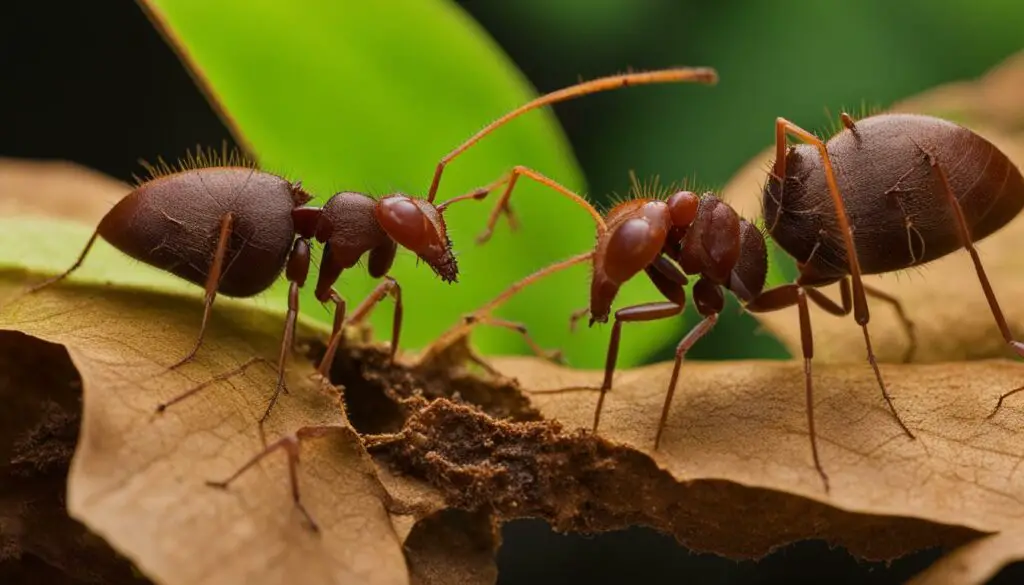
The Importance of Ants in Ecosystems
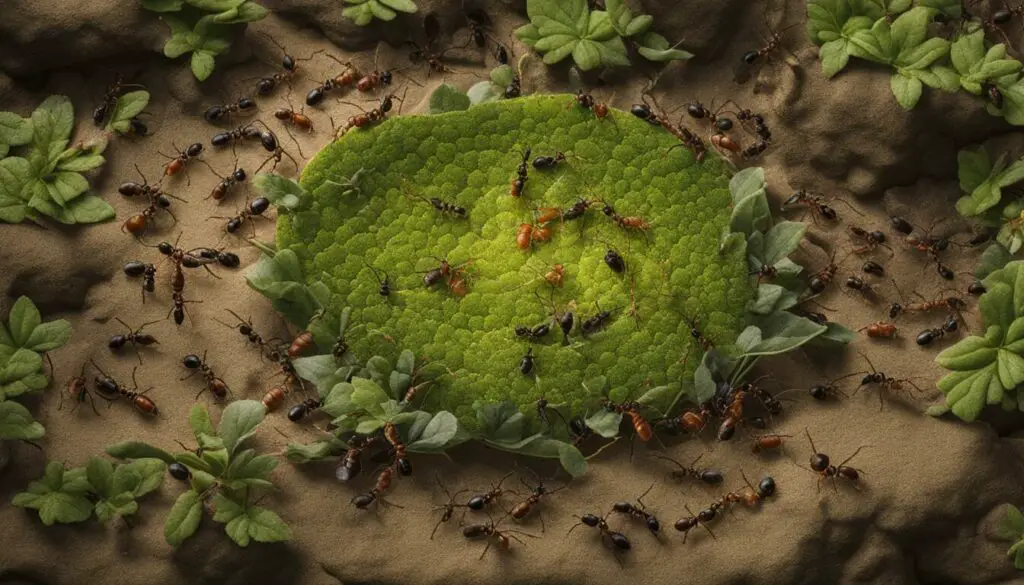
Ants play a critical ecological role in various ecosystems, contributing to the balance and health of these environments. Their diverse behaviors and interactions with other organisms have far-reaching effects on nutrient cycling, seed dispersal, and soil aeration.
One of the key ecological roles of ants is their ability to facilitate nutrient cycling. Ants transport organic matter, such as dead insects and plant debris, back to their nests. This process helps break down and decompose organic material, releasing essential nutrients into the soil. In turn, these nutrients become available for plant uptake, promoting plant growth and ecosystem productivity.
Ants also play a vital role in seed dispersal. Certain ant species collect seeds and carry them back to their nests, where they are stored or consumed. In the process, ants inadvertently transport seeds away from the parent plant, aiding in seed dispersal and promoting plant diversity. This dispersal mechanism is especially important in ecosystems with limited wind or animal dispersal, ensuring the spread of plant species.
Ants and Soil Aeration
Ants contribute to soil aeration through their intricate tunneling activities. As ants excavate their nests and forage underground, they create a network of tunnels that enhances soil structure and porosity. These tunnels facilitate the movement of air into the soil, improving oxygen availability for roots and soil organisms. Furthermore, the tunnels created by ants enhance water infiltration, reducing the risk of soil erosion and promoting overall soil health.
“Ants are ecosystem engineers, actively shaping their environment, influencing soil properties, plant diversity, and nutrient cycling.”
– Dr. Sarah Johnson, Ecology Researcher
In conclusion, ants play an integral role in maintaining the balance and functioning of ecosystems. Their contributions to nutrient cycling, seed dispersal, and soil aeration have significant implications for plant growth, biodiversity, and overall ecosystem health. Understanding the ecological role of ants is crucial in preserving and conserving these remarkable insects and the ecosystems they inhabit.
| Ecosystem Services Provided by Ants | Ants’ Ecological Role |
|---|---|
| Nutrient cycling | Transporting organic matter and releasing nutrients into the soil |
| Seed dispersal | Collecting and transporting seeds, aiding in plant diversity |
| Soil aeration | Creating tunnels that enhance soil structure and porosity |
Research and Exploration of Ants
I have always been fascinated by the intricate world of ants, and it turns out I’m not alone. Scientists and explorers have dedicated significant time and effort to studying and understanding these remarkable creatures. Through their research and exploration, valuable insights into ant behavior, social structures, and ecological importance have been uncovered.
Research on ants spans various disciplines, including biology, ecology, and entomology. Scientists have conducted experiments and observations to understand how ants communicate, organize their colonies, and interact with their environment. By studying ant behavior and social structures, researchers have gained a deeper appreciation for the complexity and efficiency of these insect societies.
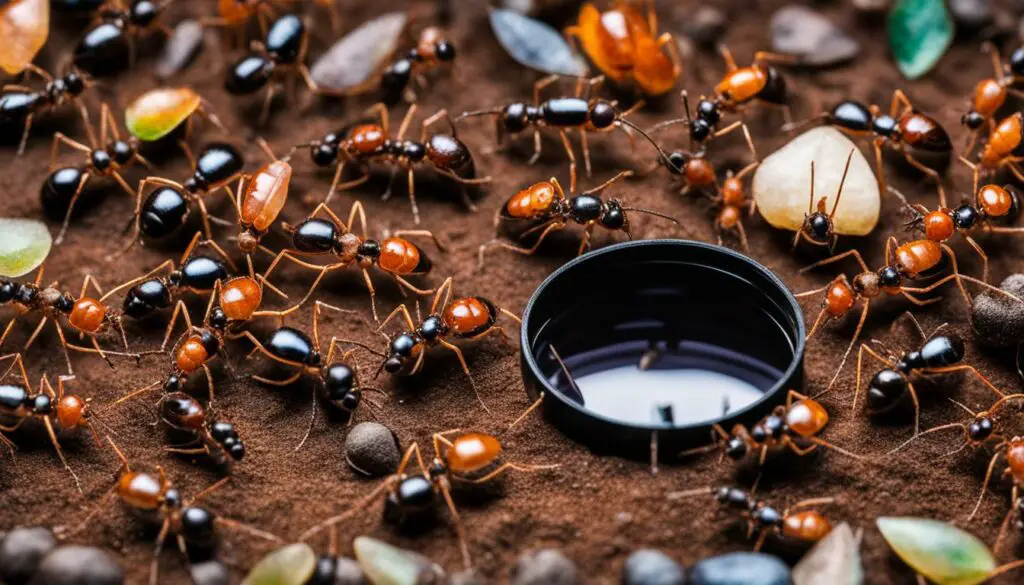
Advances in Ant Research
Advances in technology have revolutionized ant research, allowing scientists to delve deeper into their world. Microscopic imaging techniques have provided detailed insights into ant anatomy and development, shedding light on the different stages of an ant’s life cycle. Genetic analysis has helped identify the factors that influence ant behavior, such as pheromones and genetic variations within colonies.
Explorers have also ventured into unexplored regions, uncovering new ant species and documenting their behaviors in the wild. These expeditions have expanded our understanding of the diversity of ants and their ecological roles in specific habitats. Discoveries such as the leafcutter ants’ exceptional ability to cultivate fungal gardens or the incredible strength of army ants in their predatory raids have captivated scientists and nature enthusiasts alike.
| Ant Research Discoveries | Significance |
|---|---|
| The complex chemical language of ants | Reveals the intricate communication networks within ant colonies |
| Ants’ ability to farm fungi | Highlights the sophisticated agricultural practices of certain ant species |
| Ants’ role in seed dispersal | Illustrates the essential contributions ants make to plant reproduction and ecosystem dynamics |
As research continues, new discoveries and insights into the world of ants are expected to emerge. Scientists and explorers are driven by curiosity and a desire to unravel the mysteries of these tiny yet incredibly complex creatures. By studying ants, we gain not only a deeper understanding of their own societies but also valuable lessons that can inform and inspire our own human-made systems.
The Fascinating World of Ants: A Book Review
As an avid enthusiast of nature and wildlife, I was delighted to come across the book “Ants: A Visual Guide.” Written by renowned entomologist Dr. Elizabeth Williams, this comprehensive guide offers a captivating exploration of the diversity and social structures of ants. The book’s stunning illustrations and insightful text provide a window into the intricate world of these remarkable insects.
Through its beautifully crafted pages, “Ants: A Visual Guide” takes readers on a journey into the lives of ants. The book covers a wide range of topics, including ant anatomy, evolution, life cycle, and ecology. Each chapter is filled with fascinating facts and engaging narratives that shed light on the complexity of ant societies.
One of the standout features of “Ants: A Visual Guide” is its detailed profiles of iconic ant genera. From the industrious Leafcutter Ants, known for their impressive nest-building capabilities, to the formidable Pugnacious Ants, capable of decimating crab populations, the book showcases the unique characteristics and behaviors of each genus. These profiles provide a deeper understanding of the diversity within the ant world and highlight the importance of these insects in various ecosystems.
Table: Notable Ant Genera
| Genus | Characteristics | Noteworthy Behavior |
|---|---|---|
| Leafcutter Ants | Build nests with thousands of chambers | Efficiently cultivate fungus gardens for food |
| Pugnacious Ants | Aggressive and skilled hunters | Can decimate populations of crabs |
| Honeypot Ants | Unique worker caste stores food in their stomachs | Serve as living pantries for the colony |
Overall, “Ants: A Visual Guide” is a treasure trove of knowledge for anyone interested in learning about ants and their social structures. Whether you’re a casual nature enthusiast or a seasoned biologist, this book offers an accessible introduction to the world of ants. Its visually engaging format and comprehensive content make it a must-read for those fascinated by the intricate lives of these tiny yet remarkable creatures.
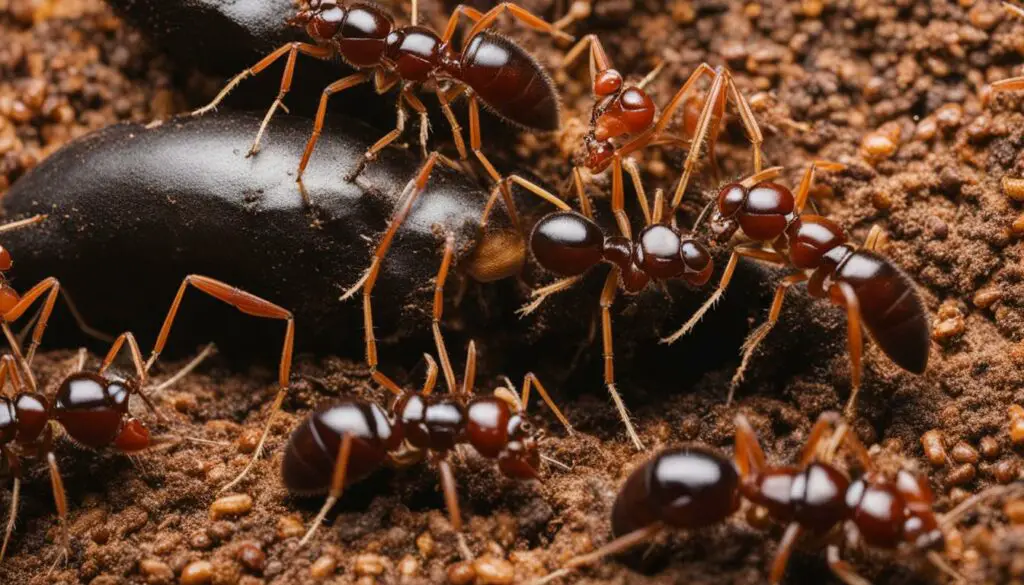
Unlocking the Secrets of Ant Construction
Ants are master builders, constructing intricate structures without the need for a blueprint or central leader. The study of ant construction provides fascinating insights into their behavior and the decentralized systems they employ. Through careful observations, advanced imaging techniques, and computer modeling, scientists have unraveled the simple rules that ants follow to perform complex tasks.
One key aspect of ant construction is the division of labor within the colony. Each ant has a specific role and task to contribute to the construction process. Some ants are responsible for excavation, digging tunnels and chambers, while others transport materials or act as architects, coordinating the construction efforts. This coordinated effort showcases the remarkable organization and cooperation present within ant colonies.
Understanding ant construction could have practical applications beyond the insect world. The decentralized systems employed by ants could inspire advancements in swarm robotics and self-healing materials. By studying and replicating the strategies that ants use to build and organize, researchers hope to create more efficient and adaptive systems that can benefit various industries.
Table: Comparison of Ant Construction Methods
| Ant Species | Construction Method |
|---|---|
| Leafcutter Ants | Leafcutter ants build elaborate nests composed of leaf fragments that they cut and mold into chambers. These chambers serve various purposes, including brood rearing and food storage. |
| Weaver Ants | Weaver ants construct nests by pulling and weaving leaves together using silk produced by their larvae. This creates a secure and intricate structure that provides protection and a suitable environment for the colony. |
| Mound-Building Ants | Mound-building ants create large mounds composed of soil particles, usually excavated from underground tunnels. These mounds provide shelter and regulate temperature and humidity within the colony. |
As we continue to unlock the secrets of ant construction, we gain a deeper appreciation for the complexity and ingenuity of these tiny builders. Ants serve as a testament to the power of decentralized systems and the remarkable feats that can be achieved through collaboration and specialization. By studying ants, we not only gain insights into their own world but also inspire innovation in our own.
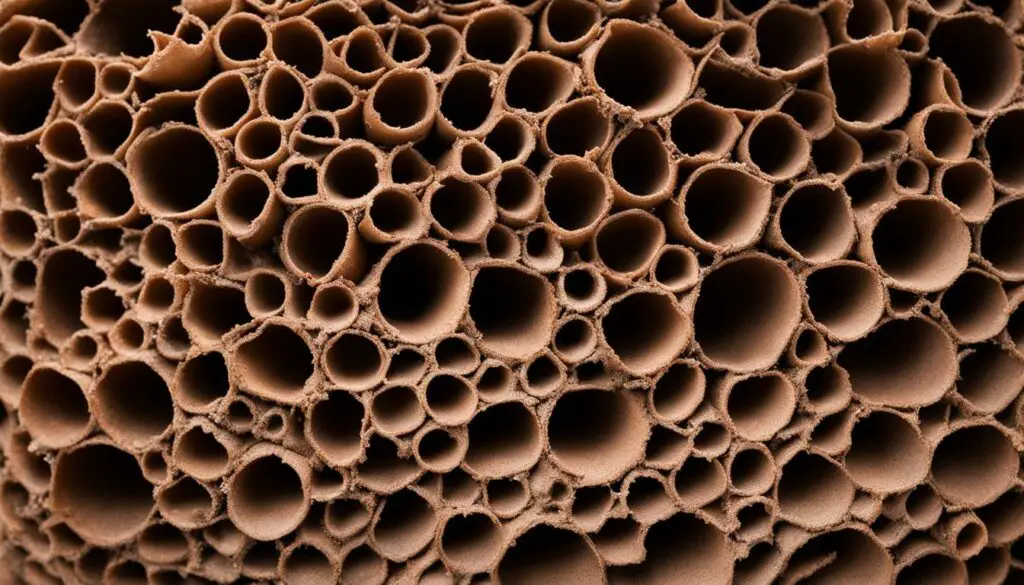
Conclusion
I hope this article has provided you with a fascinating insight into the world of ants and their intricate social structures. By exploring ant behavior, communication, and organization, we can gain a deeper understanding of the complexity and organization of insect societies.
Ants, with their diverse behaviors and division of labor, are fundamental to the survival of ecosystems. They contribute to nutrient cycling, seed dispersal, and soil aeration, playing a crucial ecological role. Studying ants not only reveals the wonders of their own world but also offers valuable lessons for understanding and improving complex biological and human-made systems.
From the incredible diversity of ant species to the important role of the queen and the division of labor within colonies, every aspect of ant social structures is worth exploring. By unlocking the secrets of ant construction and understanding their communication methods, we gain insights that could have applications in various fields, from swarm robotics to self-healing materials.
For those interested in delving deeper, I recommend the book “Ants: A Visual Guide.” This comprehensive guide beautifully illustrates the diversity and social structures of ants, providing an accessible introduction to these remarkable insects. So, let’s continue to explore the fascinating world of ants and uncover the wonders they hold.
FAQ
What is the role of ants in ecosystems?
Ants contribute to nutrient cycling, seed dispersal, and soil aeration, helping maintain the balance and health of ecosystems.
How do ants communicate?
Ants communicate using chemical signals called pheromones, which help them coordinate tasks, mark trails, and recognize colony members.
What is the division of labor in ant colonies?
Ant colonies have a strict division of labor, with worker ants responsible for foraging, food storage, nest maintenance, and caring for the queen’s offspring.
What are some standout genera of ants?
Leafcutter Ants build nests with thousands of chambers, Pugnacious Ants can quickly destroy populations of crabs, and Honeypot Ants have a unique worker caste that stores food in their stomachs for other colony members to consume.
What is the importance of the ant queen?
The queen ant is responsible for reproduction and laying eggs, ensuring the growth and survival of the colony.
What is the book Ants: A Visual Guide about?
Ants: A Visual Guide is a comprehensive and beautifully illustrated book that explores the diversity and social structures of ants, covering topics such as anatomy, evolution, life cycle, and ecology.
How do ants construct intricate structures without a blueprint?
Scientists have discovered that ants follow simple rules to perform complex tasks, and studying ant construction could have applications in swarm robotics and self-healing materials.
What can we learn from studying ants?
Studying ants not only sheds light on their own world but also offers valuable lessons for understanding complex biological systems and improving human-made systems.

